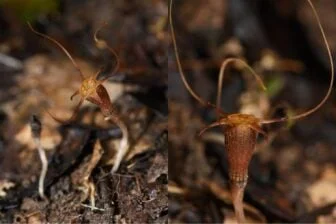
The Enigmatic Discovery of Thismia Aliasii: A Fairy Lantern in Peril
Deep within the lush hills of Terengganu, Malaysia, an extraordinary botanical wonder has emerged, captivating researchers and conservationists alike. The newly identified species, Thismia aliasii, often referred to as the "fairy lantern," is a poignant reminder of the delicate balance within our ecosystems and the urgent need for conservation efforts.

Discovered by researcher Mohamad Alias Shakri during a 2019 expedition, this striking plant was found nestled alongside a popular hiking trail in the Chemerong Forest Eco Park. The extraordinary floral structure, shimmering with hues of orange and yellow, signals its unique survival strategy: it is mycoheterotrophic and completely reliant on fungi for nourishment, foregoing photosynthesis entirely. This symbiotic relationship underscores a fascinating evolution hidden from most hikers and nature enthusiasts.
Despite its captivating appearance, Thismia aliasii faces dire circumstances. The species has been classified as "Critically Endangered" by the IUCN Red List, with only five documented individuals observed in various surveys. Habitat degradation fueled by increased foot traffic from hikers poses the greatest threat to its survival, highlighting a fragile existence that could easily go unnoticed amid the bustling outdoor activities surrounding it.
Researchers note the plant's remarkable defensive adaptations, relying on specialized pollination systems involving small insects like fungus gnats. These intricate dynamics further emphasize the species' vulnerability, as changes within its habitat could disrupt its entire life cycle. Siti-Munirah Mat Yunoh, another key researcher behind the discovery, poignantly expressed the challenges faced during their quest to gather specimens, especially in light of the COVID-19 pandemic, which delayed essential fieldwork.

This fascinating revelation not only enhances Terengganu's reputation as a biodiversity hotspot—with 13 recognized species of Thismia, including six endemics—but also serves as a call to action. The balance between conservation and leisure activities necessitates greater awareness and stricter regulations in areas rich with unique flora. “Public awareness, trail regulations, and scientific monitoring become crucial elements of the solution,” emphasizes Yunoh.
As we stand on the brink of irreversible biodiversity loss, discoveries like Thismia aliasii compel us to rethink our role in conservation—recognizing that even the smallest of plants can hold profound significance in the grand tapestry of life. How can we, as stewards of the Earth, advocate for their survival amidst their pressing realities? What small steps can we take to protect our planet’s most vulnerable inhabitants?
Share your thoughts and ideas in the comments below and let’s spark a conversation about conservation efforts that matter.